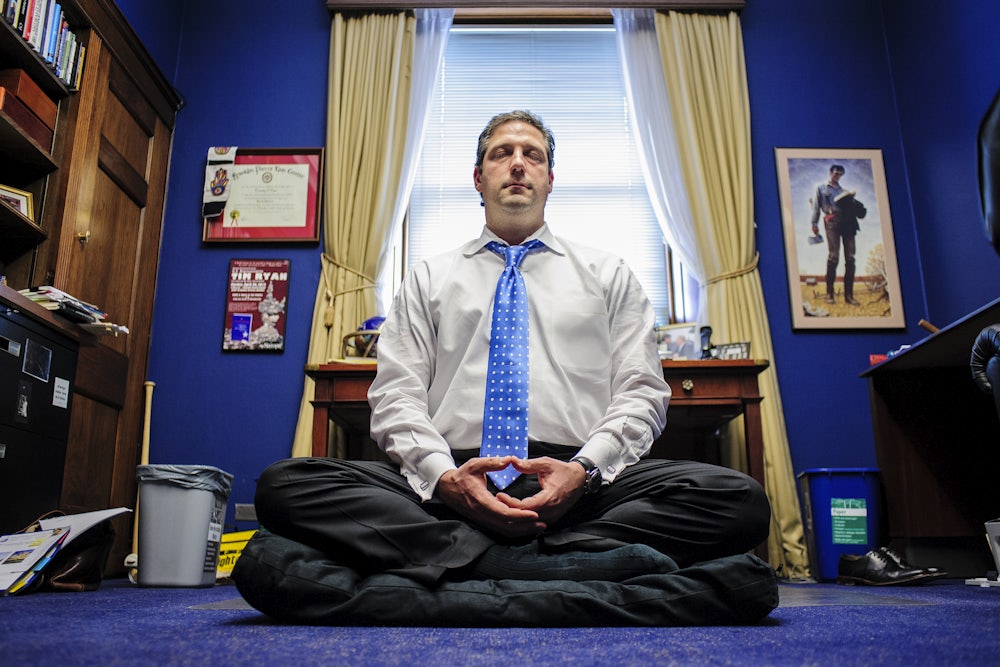In late 1994, a few days after Christmas, Hillary Clinton and her husband retreated to the woods. They had had a bruising few months. The Republicans had retaken the House, and Clinton wanted a reset. So, she invited an anthropology professor, three writers—including miracle worker Marianne Williamson, the author of A Return to Love—and a psychic named Jean Houston to Camp David. Houston believed that with “dreamworlds” and trances she could reach back in history and expand the range of human consciousness. (She had a particularly close relationship with the Greek goddess Athena—they talked on the computer—and taught seminars in ancient mythology at a traveling institute she’d founded in the 1980s, the Mystery School.) That spring, their sessions continued. Behind closed doors in the White House solarium, Houston and Clinton meditated together, communing with the spirits of Eleanor Roosevelt and Gandhi.
When Bob Woodward published details from their “brainstorming sessions” in his 1996 book, The Choice, conservatives called Clinton a Satanist and the sessions “witch ritual.” A couple of decades later, however, meditation has gone mainstream; one in three Americans has tried yoga, and Democrats are not only talking about New Age ideas, they’re framing them as a source of the wisdom and calm they’d need as president.
After the election of Donald Trump, Kirsten Gillibrand told Refinery29 she recovered with “lots of yoga and Pilates.” On CNN, Clinton demonstrated nadi shodhana, a yogic alternate nostril breathing technique. Tulsi Gabbard, for her part, is fond of describing her conversion to Hinduism as a teenager. Her parents, who homeschooled her in Hawaii, exposed her to a multitude of religions; she chose Hinduism, which, she says, has brought her “wisdom and spiritual solace.” Cory Booker has taught yoga to high schoolers in Newark and tweeted “Namaste” to his followers. Marianne Williamson is running for president herself, promising to “harness dignity, decency, and love for political purposes.” In interviews, Beto O’Rourke quotes New Age ideas, with such koans as “your will is the subconscious author of your life.” And Representative Tim Ryan—a Democrat from Ohio’s steel valley who has written two books on mindfulness (he runs the House’s “Quiet Time Caucus,” teaching meditation techniques derived from Buddhism to his fellow public servants)—has also launched a presidential bid. He’s “not some soft yoga guy,” he hastens to tell interviewers (he played football in high school), but he says he’ll win with “the yoga vote.” Mindfulness, he believes, has the “potential to help transform core institutions in America—school, hospitals, the military, and social services.”
The “yoga vote” is merely the new name for an old political trope: the college-educated white woman. Studies show that 72 percent of America’s 36 million regular yoga practitioners are women. Most are white, with the disposable income to spend around $15 on a yoga class three times a week. Democrats have been courting such women since the 1990s. (Bill Clinton built his campaign strategy around winning over white suburban moms.) They’re still important in Democratic politics. Just two years ago, they forcefully marched on Washington to protest the election of an alleged sexual predator to the highest office in the land.
If Democrats want to reach such women, yoga makes sense. Yoga culture is, for the most part, progressive but not leftist, compassionate but not revolutionary. It’s a good match for someone who might live in Austin, Texas; Boulder, Colorado; or San Francisco, California, cities that pride themselves on their progressivism, but where affluent liberals—the kind that buy Goop products, shop for organic produce, practice mindfulness and a light version of spirituality—hold more conservative stances on taxes and government spending.
Still, there are downsides to embracing such rhetoric. Expensive exercise studios, vegan diets, and meditation classes are status symbols, available only to the few who can afford them. For the rest, life expectancy is going down. Nineteen million Americans live too far away from the nearest grocery store to get fresh produce on a regular basis, and even greater numbers can’t afford to see a dentist. It might seem out of touch, at best, for a presidential candidate to lecture them on the benefits of a healthy lifestyle, or to tell a minimum-wage worker who has to hold two part-time jobs to take time to be “fully in the present.” The present, for many American workers, isn’t all that great.
When Beto O’Rourke told The Washington Post earlier this spring, “your will is the subconscious author of your life,” he was paraphrasing Joseph Campbell, the mythologist. Campbell embodies an enlightened, secular culture popular with yoga goers and Silicon Valley bros alike. To him and his adherents, each person is the hero of their own journey toward truth and power—a pleasing story for those who fancy that they rose to the top on merit alone, but one that is less appealing for those held down in an economy that actively works against them. Democrats ought to be reaching out to those voters, promising to distribute resources fairly. A place on a yoga mat might seem innocuous enough, but it’s an inadequate substitute for a place at the table.
